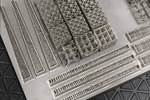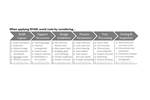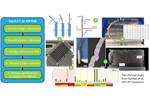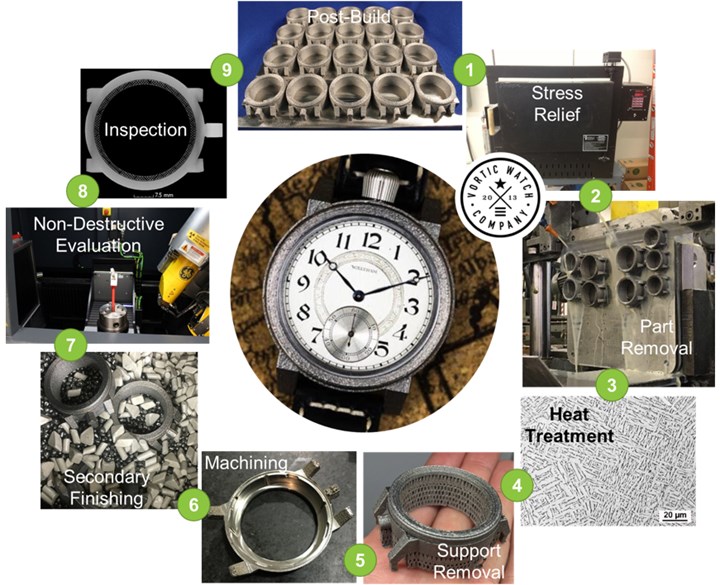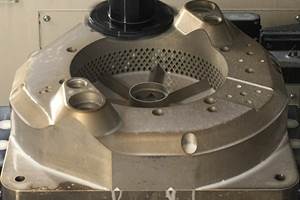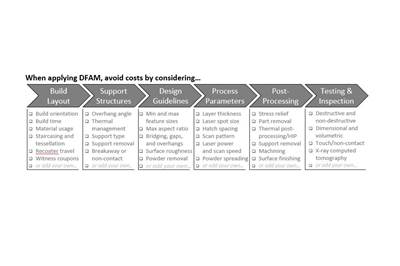Reframing Post-Processing for Additive Manufacturing
Post-processing for additive manufacturing can add time and cost to production – but it can also mitigate risks.
Post-processing of metal laser powder bed fusion parts often entails (1) stress relief to reduce warping, (2) removal of parts from the build plate to help establish datums for machining, (3) heat treatment to reduce microstructural variation, (4) removal of supports that reduce distortion during the build, (5) machining to reduce dimensional non-conformance, (6) secondary finishing to reduce surface effects, (7) non-destructive evaluation to avoid defects and (8) inspection to ensure dimensional integrity. Photo Credit: Tim Simpson.
Getting to a profitable part with additive manufacturing requires careful attention to a variety of factors that impact performance and drive cost. Among these many factors is the extent of post-processing that must be done to the part after layer-wise fabrication ends.
Post-processing is rarely viewed in a favorable light. All too often, it is treated as a “necessary evil” that adds cost and schedule to an otherwise already expensive manufacturing process.
For polymer 3D printed parts, post-processing can be as simple as dropping the part into a washing system to dissolve and remove unwanted support structures or using acetone vapor smoothing to help make the part watertight. Some polymer 3D printed parts may require additional post-processing to achieve tolerances and surface finishes, but machining plastic parts does not cause as much headache as working with metals.
For metal AM parts, post-processing is substantial, and it can easily double the cost and time it takes to 3D print the part layer-by-layer. As shown in the figure above, metal parts made with laser powder bed fusion typically undergo stress relief before parts are removed from the build plate. Parts are often heat treated (or undergo solution annealing, aging or hot isostatic pressing) before support removal and machining to meet tolerances. Secondary finishing operations (for example, tumbling, abrasive flow machining, electrochemical polishing) may be used for additional surface treatment. Finally, parts are inspected prior to their assembly or end-use. Iterations may occur throughout this process, and the duration and cost of each step will be determined by a variety of factors, including the criticality of the part, qualification guidelines and certification requirements, to name a few.
We spend so much time focusing on cost reduction (and cost avoidance) that we lose sight of the fact that post-processing helps mitigate the risks associated with layer-wise fabrication. Yes, each step adds time and cost to production, but consider the alternatives:
- Stress relief helps reduce the residual stresses that accumulate in a metal part as the laser heats the material and subsequently cools it during the build process; without it, there is a risk of a part warping or even cracking once it is removed from the build plate.
- Removing parts from the build plate helps create a reference plane for establishing datums; without it, there is a risk of not being able to orient or fixture the part properly for machining.
- Heat treatment helps homogenize the microstructure and reduce material heterogeneity in the part; without it, there is a risk of the part failing due to build orientation effects or other microstructural weaknesses that can arise during the build.
- Support removal eliminates extra material that is added during the build to help reduce distortion of features on the part; without supports, there is a risk of having a build failure if the part warps too much and causes an issue when a new layer of powder is added.
- Machining helps achieve the specified geometric dimensions and tolerances; without it, there is a risk of dimensional nonconformance and rejecting the part.
- Secondary finishing operations can enhance surface properties and improve the appearance of the final part; without them, there is a risk of surface effects that may lead to premature part failure or surface flaws that detract from the intended aesthetic.
- Inspection and nondestructive evaluation help ensure dimensional and volumetric integrity; without them, there is a risk of dimensions being out of specification or internal defects going unnoticed, both of which can cause part failure.
Because there are so many steps after the build is complete, considerable attention is spent trying to combine, reduce or eliminate post-processing for metal AM. For example, people often ask:
- Can we combine stress relief and heat treatment to save time? Yes, but depending on the type and extent of the heat treatment, the build plate may distort, creating subsequent challenges with part removal.
- Can we use “breakaway” supports that are easier to remove? Yes, but they may leave nubs or rough spots on the surface that will need to be removed later.
- Can we specify tolerances to avoid machining the part all over? Yes, but this necessitates an understanding and questioning of the underlying requirements that are often specified or taken as a given.
- Can we use bulk finishing processes to reduce surface roughness? Yes, but geometry and size may limit accessibility to some features depending on their location and dimensions.
- Can we avoid having to use costly X-ray computed tomography (CT) scanning to inspect every part? Yes, but only if quality control procedures have been properly implemented and maintained to ensure consistent layer-wise processing.
In short, there is still a lot of room for creativity and innovative solutions in the post-processing of metal AM parts. I encourage machining professionals and manufacturing experts out there to talk to an AM service provider or a company making AM parts in-house to see how they can help de-risk the process even more. While post-processing is a cost for them, it is an opportunity to share valuable knowledge and insights to help the fledging AM industry thrive because when that happens, everyone wins.
Related Content
The Benefits of Vertically Integrating Metal 3D Printing and Machining
Having 3D printing and machining within one organization enables Addman’s engineers to collaborate and consolidate so it can quickly make successful metal 3D printed parts.
Read MoreAn Additive Manufacturing Machine Shop
Finish machining additively manufactured implants requires different pacing and workflow than cutting parts from stock — different enough for an experienced manufacturer to warrant a dedicated machine shop.
Read More10 Ways Additive Manufacturing and Machining Go Together and Affect One Another
Forget “additive versus subtractive.” Machining and metal additive manufacturing are interconnected, and enhance the possibilities for one another. Here is a look at just some of the ways additive and machining interrelate right now.
Read MoreAdditive/Subtractive Hybrid CNC Machine Tools Continue to Make Gains (Includes Video)
The hybrid machine tool is an idea that continues to advance. Two important developments of recent years expand the possibilities for this platform.
Read MoreRead Next
How Prototyping Addresses Unknowns and Reduces Risks
One benefit of metal AM is the capability to create functional prototypes in less time, enabling you to rapidly iterate on design alternatives during development.
Read MoreAvoiding Costs while Adding Value with DFAM
Design for Additive Manufacturing (DFAM) is as much about finding value as it is about avoiding costs with AM.
Read MoreSmart, Fast Prototyping Informs Redesign for AM
Rapid intelligent prototyping can reveal how best to proceed when developing design guidelines for additive manufacturing.
Read More

